Dubai Museum of the Future: Innovation and Impact
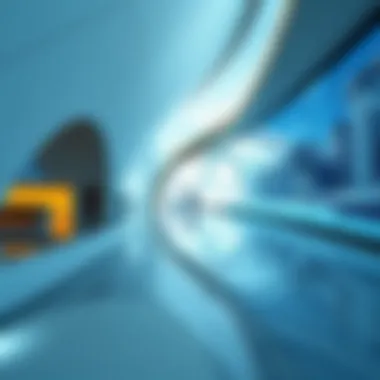
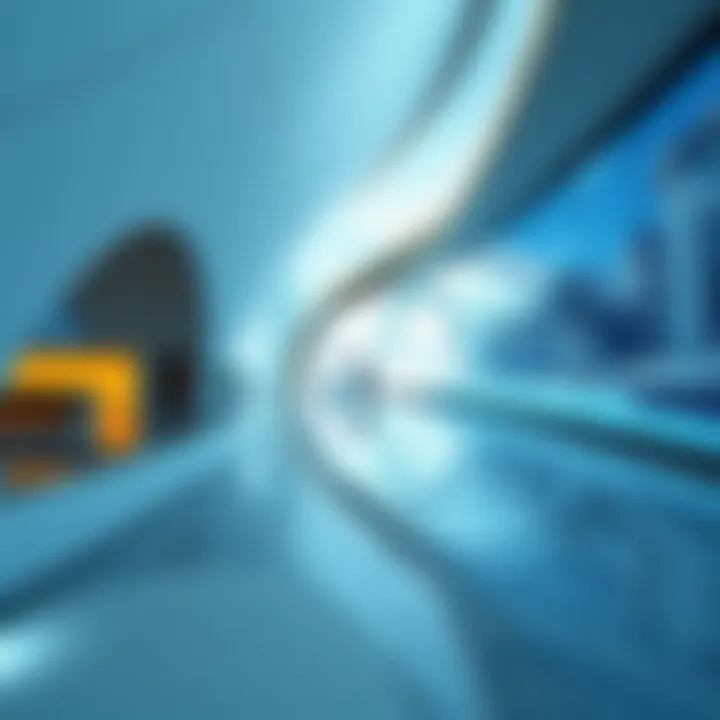
Intro
The Dubai Museum of the Future is not just a museum; it is a bold statement about the future itself. Nestled in the heart of Dubai, it symbolizes a commitment to innovation, sustainability, and cultural heritage. This institution is a place where the realms of technology, art, and social development converge, offering insights that resonate both locally and globally. It stands as a lighthouse guiding investors and homebuyers toward the future of real estate in this vibrant city.
Understanding the significance of this museum extends beyond its visually striking architectural design. It prompts an exploration into how such a space can influence the economic landscape, particularly in the burgeoning real estate sector of Dubai. So, let's journey through various aspects of the museum, incorporating market insights and investment opportunities that arise from its presence.
Market Insights
Latest Trends in Dubai Real Estate
In recent years, the Dubai property market has been showing a robust evolution, with various trends shaping its landscape. Investors are witnessing an influx of tech-savvy developments. Mixed-use projects combining residential, commercial, and leisure components have become increasingly popular. The Museum of the Future has accelerated interest in areas surrounding it, with potential for growth seen in the neighborhoods close to this striking landmark.
- Smart Homes and Sustainability: Eco-friendly residential options are gaining traction. Properties that offer energy efficiency and smart technology are highly sought after.
- Rising Popularity of Luxury Spaces: As disposable incomes rise, there's an increase in demand for luxurious living spaces. Prospective buyers value high-end amenities and design.
- Short-term Rentals on the Rise: Sites like Airbnb are making short-term rental properties a viable investment avenue, appealing to tourists flocking to experience innovation firsthand.
Impact of Global Events on Local Market
The global landscape undeniably affects local markets, and Dubai is no stranger to these shifts. Events like the pandemic have changed how people view space and community.
"In the wake of global shifts, Dubai real estate has shown resilience, adapting to new norms and embracing innovative solutions."
Factors influencing this adaptation include:
- Remote Work Trends: As businesses transition to flexible work arrangements, there's a noticeable shift toward properties that accommodate home offices and communal workspaces.
- Increased Tourism: Major attractions, like the Museum of the Future, continue to draw visitors, boosting the local economy and property demand.
- Economic Initiatives: The Dubai government has implemented various policies to attract foreign investors, further solidifying its position as a real estate hub.
Investment Opportunities
High-Return Areas for Property Investment
Being strategic about property investment can lead to substantial returns. Areas near key attractions, like the Museum of the Future, are expected to witness increased demand over time.
- Downtown Dubai: A vibrant locale on the rise, offering trendy living accommodations and high ROI.
- Business Bay: With its proximity to major commercial hubs, this area is becoming a favored spot for residential developments.
- Dubai Marina: With waterfront views and a lively atmosphere, properties here often attract premium buyers.
Tips for First-Time Investors
Navigating the property market can seem daunting, but a few guiding principles can ease the journey:
- Research Local Trends: Stay updated on market fluctuations and understand key drivers of growth.
- Engage with Local Experts: Networking with real estate agents and local investors can provide insights you might overlook.
- Consider Long-Term Viability: Invest in properties that not only have short-term appeal but also are likely to appreciate in value over time.
Preface to the Museum of the Future
The Museum of the Future is more than just a museum; it embodies Dubai's ambitious vision for a world that is constantly in flux. At its core, this institution is designed to inspire innovation and embrace the possibilities that lie ahead. Visitors stepping into the museum find themselves immersed in a space where the boundaries of reality are pushed and the extraordinary becomes the norm. The sheer concept of this museum challenges conventional notions of what a museum is supposed to be.
In this ever-evolving landscape, the museum serves as a vital resource and hub, especially for investors and homebuyers looking to stake their claim in a city that’s not just keeping up with the world but setting the pace for it. Here, technology interplays with art and history, offering a profound narrative that is deeply connected to human experiences.
Overview of Concept
The design concept of the Museum of the Future is illustrated by its unique structure—an elliptical building without corners, which stands as a metaphor for looking ahead, embracing the unknown. This architectural marvel is not merely a façade; each curve and angle is intentional, reflecting the innovative spirit that Dubai prides itself on. Additionally, the exterior features poetic inscriptions in Arabic, tying the museum to its cultural roots.
This museum is more than a display of futuristic concepts; it serves multiple purposes—from a platform for thought-provoking exhibitions to spaces for workshops aimed at young innovators. The idea is to create an interactive experience where visitors can not only observe but also engage, think, and participate in dialogues about the future.
Cultural and Historical Context
To truly appreciate the Museum of the Future, one must consider its cultural and historical backdrop. Dubai's rapid transformation from a modest fishing village to a global metropolis is a story of visionary leadership and relentless ambition. The museum stands as a testament to this journey, encapsulating the essence of this progression.
The city has a rich tapestry of influences from the Silk Road and trade routes, which has shaped its modern identity. By contextualizing the Museum of the Future within this rich history, one gets a deeper understanding of its mission. It is about connecting the past with the present, and navigating towards the future while respecting and learning from the journey that has brought Dubai to its current stage.
Moreover, the museum's emphasis on sustainability resonates with the global movement toward greener practices. It reflects a deeper understanding of our collective responsibility as stewards of the planet. This cultural lens is pivotal for discerning investors and expats alike, as it adds layers of meaning to their experiences in a city rich with both heritage and innovation.
Architectural Design and Features
The architectural design and features of the Dubai Museum of the Future are crucial not only for its aesthetic appeal but also for its role in corporate symbolism and urban identity. The museum stands as a statement of vision, innovation, and open-mindedness, and the architectural elements play an integral part in manifesting these ideas. The interplay of form, material, and technology not just crafts a unique visitor experience but also positions Dubai as a hub for cutting-edge development and architecture.
Inspiration Behind the Design
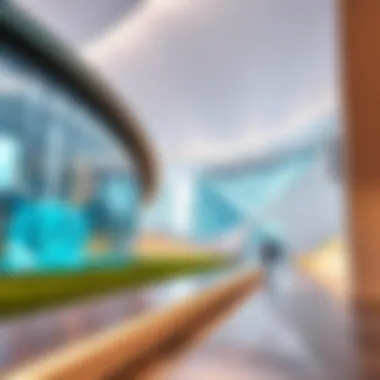
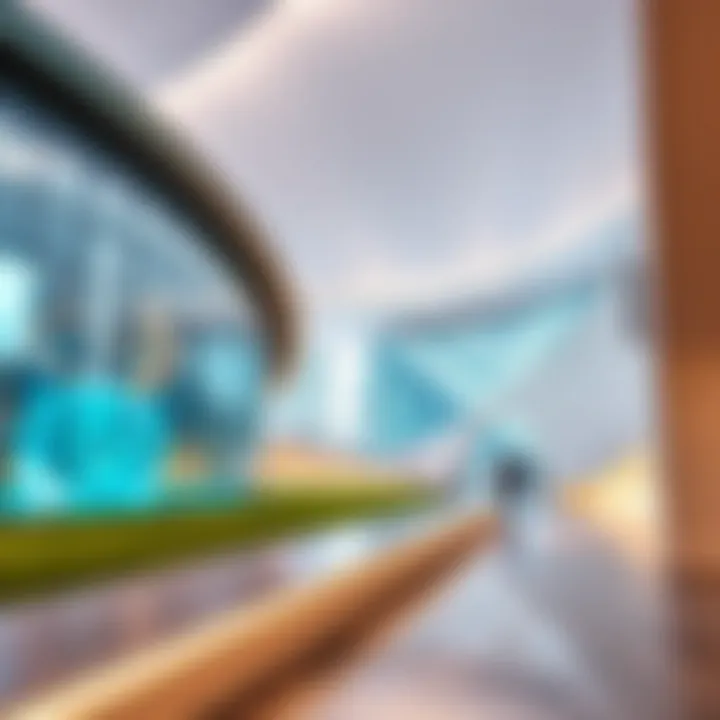
The inspiration behind the design of the Museum of the Future stems from a merging of traditional Islamic architecture and futuristic visions. The building’s graceful curves and unique torus shape symbolize the cycle of life and future possibilities. This juxtaposition reflects a depth in culture while looking forward. The acclaimed architect, Shaun Killa, envisioned a space that encourages thought and dialogue, offering an immersive experience that shifts the perspective of what a museum represents.
This isn’t just about looking ahead; it’s about anchoring in a rich cultural heritage. The Arabic calligraphy adorning the façade is not merely decorative, but invites curiosity through its messages, bringing art and thought together in a striking visual narrative. Each design choice expresses a bridge between history and the digital, letting visitors see the future within the past.
Materials and Sustainability
In terms of materials and sustainability, the museum stands as a benchmark. A significant consideration in the design was incorporating sustainable practices to promote environmental consciousness. The exterior is clad in a special material that not only enhances thermal performance but is also made from lightweight materials, reducing the overall carbon footprint of the structure.
Additionally, the building aims to achieve LEED Platinum certification, aligning with Dubai's broader sustainability goals. The integration of solar panels and water conservation systems illustrates a design ethos that respects the environment. This way, structures like the Museum of the Future show how elegance and eco-friendliness can coexist, potentially influencing developers in the region to adopt similar practices.
Technological Innovations in Structure
The technological innovations embedded in the museum’s structure enhance not just its aesthetic value but also its functional capabilities. The building employs advanced facade systems that adapt to the natural environment, providing insulation while maintaining a sleek appearance. Furthermore, the integration of state-of-the-art building management systems ensures that energy is utilized efficiently.
One particularly eye-catching aspect is the digital display technology utilized in projections, which are designed to create a dynamic interaction with visitors. These installations engage audiences creatively, providing insights into anticipated challenges and breakthroughs in various fields, from climate science to artificial intelligence. This level of integration of technology sets a precedent, likely inspiring urban developers and architects worldwide to rethink how future structures may communicate with their inhabitants.
In summary, the architectural design and features of the Dubai Museum of the Future not only establish a physical landmark but also embody a deeper narrative about sustainability, heritage, and forward-thinking. Such intentions make it vital for potential investors, homebuyers, and policymakers to recognize both the aesthetic and functional significance of this landmark in shaping Dubai’s future.
Exhibitions and Experiences
The exhibitions and experiences at the Dubai Museum of the Future serve as a crucial element in the overall narrative of innovation and exploration. They not only encapsulate the museum's visionary spirit but also represent the intersection of technology, culture, and human curiosity. Each installation and exhibit aims to engage visitors, making abstract concepts tangible and relatable.
Interactive Installations
At the core of the museum’s offerings are its vibrant interactive installations. These elements are designed to provoke thought and stimulate engagement, inviting visitors to step into scenarios that challenge their expectations of the future.
One notable installation showcases predictive technology, simulating various aspects of life, such as work, education, and travel in a futuristic world. Imagine stepping into a room that generates real-time projections of your future self based on artificial intelligence inputs and personal algorithms. Visitors can witness first-hand how choices made today could forge paths for tomorrow.
Benefits of interactive exhibitions include:
- Enhanced Learning: Engaging audiences through tactile experiences aids retention and understanding.
- Diverse Audience Appeal: By appealing to different learning styles, these installations make the museum accessible to a broader demographic.
- Encouraging Dialogue: The interactive nature fosters discussions among visitors and between visitors and guides, enriching the experience.
Engagement with Future Technologies
The museum also emphasizes engagement with future technologies. Each exhibit not only showcases advanced concepts but encourages visitors to interact with them. For instance, the use of virtual reality (VR) and augmented reality (AR) provides immersive experiences that redefine how people learn about potential technological advancements.
Imagine donning a VR headset and finding yourself in a city that reflects the UN’s sustainability goals, where energy is harnessed from renewable sources, and transportation operates on smart grids. These experiences empower visitors to envision solutions to some of the pressing challenges faced by urban areas today.
Advantages of engaging with such technologies include:
- Skill Development: Interacting with innovations arms individuals with knowledge and skills that are directly applicable in the real world.
- Networking Opportunities: Visitors often engage with industry leaders and innovators, opening doors to collaboration or investment.
- Inspiration for Local Initiatives: Many visitors return home inspired to implement change on a local level, mirroring the innovative ideas they encountered.
In summary, the exhibitions and experiences at the Dubai Museum of the Future are not mere showcases. They catalyze a deeper understanding of the potential of technology to shape our world. Visitors leave not just with newfound knowledge but often a renewed sense of optimism about the future—an essential takeaway in today's rapidly evolving landscape.
"The future belongs to those who believe in the beauty of their dreams."
— Eleanor Roosevelt
Those interested in more information can visit Dubai Museum of the Future official site or check resources at en.wikipedia.org for further readings.
Impact on Tourism and Economy
The Museum of the Future is not just another architectural marvel in Dubai; it's a linchpin in the city’s growing tourism narrative. This section explores the various ways the museum stands to influence not only an uptick in visitors but also a broader economic landscape in Dubai. From attracting international tourists to reinforcing local businesses, the impact is multifaceted, especially for investors and developers engaged in the bustling market.
Attraction for Global Tourists
The allure of the Museum of the Future spans across a variety of demographics, transforming it into a major draw for global tourists. With its unique approach to exhibitions centered around futuristic concepts, the museum appeals to tech enthusiasts, families, and cultural explorers alike. Visitors are reconsidering their travel itineraries, placing the museum high on their must-see lists.
Here are a few key elements contributing to its attractiveness:
- State-of-the-Art Exhibits: The interactive installations are designed to engage and immerse visitors in meaningful discussions about tomorrow's challenges, drawing tourists who long to witness groundbreaking innovations.
- Cultural Engagement: By showcasing not just local culture but also international perspectives on future issues, the museum offers a rich tapestry of experiences that resonate with a broad audience.
- Prominent Location: Nestled near other significant attractions like the Burj Khalifa and Dubai Mall, the museum is perfectly situated to capture the foot traffic of tourists already exploring the city.
Additionally, word-of-mouth and social media buzz amplify its visibility. Taker a look at platforms like Facebook and Instagram, where diverse global communities share their experiences.
"Tourists are not solely looking for places to visit; they crave experiences that provoke thought and inspire. The Museum of the Future embodies that desire."
Economic Benefits for Dubai
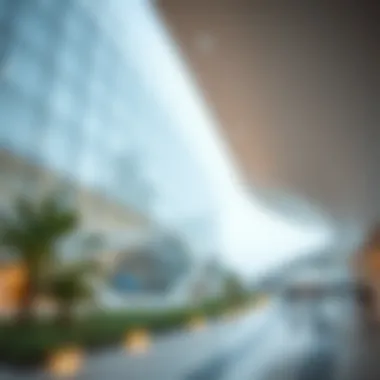
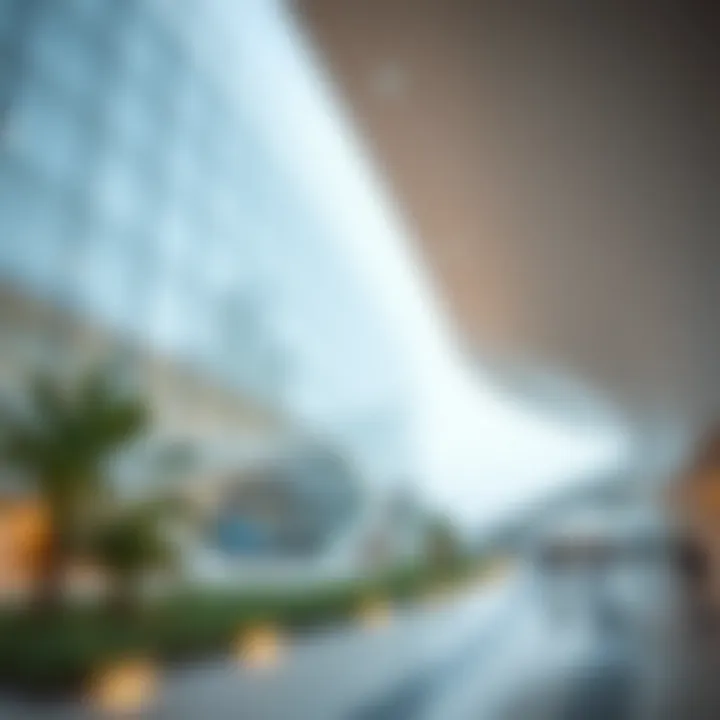
The economic implications of having the Museum of the Future in Dubai extend beyond immediate tourism revenues. Over time, these benefits cascade into various sectors of the economy.
- Job Creation: The museum demands a workforce ranging from curators to tech specialists, thus generating numerous employment opportunities within the local community.
- Support for Local Businesses: Increased foot traffic in the area translates to more customers for local shops and restaurants, spurring overall economic vitality.
- Investment Attraction: The museum itself acts as a magnet for international investments in both tourism and technology sectors, fostering a surge in related businesses.
- Increase in Property Values: As the museum enhances the region's appeal, property values in the vicinity are likely to rise, benefiting homeowners and investors alike.
In summary, the Museum of the Future doesn’t just contribute economically in measurable terms; its ripple effects are likely to redefine Dubai’s standing as a global city committed to innovation and culture.
Relevance to Real Estate Market
In today’s world, where innovation and future-thinking dictate the tempo of urban development, the Dubai Museum of the Future plays a pivotal role in shaping the real estate landscape in Dubai. This is not merely about a unique architectural structure; it’s about the far-reaching ripples that the museum generates in property value, investment potential, and overall market dynamics. The interplay between cutting-edge design and real estate is profound, as developments like this catalyze not just interest from investors but shift perceptions about what living in, or investing in, Dubai entails.
Proximity to Significant Developments
The location of the Dubai Museum of the Future isn't just a matter of chance; it’s a strategic choice that enhances its relevance. Nestled alongside other monumental projects, like the iconic Burj Khalifa and the Dubai Mall, this museum creates a compelling narrative of progress. The immediate vicinity to high-profile developments draws attention from international investors. This area, brimming with potential, is becoming a hub for those seeking to capitalize on a flourishing market. The Dubai Design District and the Business Bay area also sit nearby, adding to a portfolio that is attractive to both residential and commercial property seekers.
When considering real estate investments, proximity to major attractions like the Museum of the Future signals not only desirability but also promising rental yields. Areas close to such landmarks often see increased foot traffic and demand, leading to upward pressure on property prices as well. Investors looking to maximize returns will find this locale particularly appealing as it embodies the spirit of a city that thrives on innovation and luxury.
Influence on Property Values
The presence of the Dubai Museum of the Future is undoubtedly a boon for neighboring property values. As a beacon of modernity, it not only enhances the aesthetic and cultural appeal of the area but also raises the stakes for adjacent real estate. Properties in close proximity to innovative landmarks typically report strong appreciation rates, which is quite instrumental for investors.
Moreover, as Dubai positions itself as a global center for creativity and technology, the property's value transcends physical dimensions. The narrative created by the museum, focusing on sustainability and future technologies, enhances desirability. It sends a strong message that the region is forward-thinking and primed for future developments. Investors are increasingly valuing not just the space they purchase but also the storytelling and vision behind it.
In many cases, market trends have shown that areas adjacent to such iconic developments can experience a property value increase of about 15-25% within a few years of establishment. Besides boosting home buying confidence, proximity to the museum also signals to investors that they are part of a thriving ecosystem ripe for growth.
An investment in a property near the Museum of the Future signifies more than real estate; it symbolizes a step into the narrative of progress that Dubai encapsulates.
In summary, the incorporation of a unique cultural institution like the Dubai Museum of the Future into the urban fabric has deep-rooted implications for the real estate market, making it an essential factor for investors and homebuyers keen on securing their stake in Dubai's lively market.
Educational Outreach and Programs
Educational outreach plays a pivotal role in the ethos of the Dubai Museum of the Future. This approach isn’t just about teaching about technology; it involves fostering a sense of curiosity, encouraging critical thinking, and promoting innovation among diverse audiences. For investors and homebuyers looking for long-term value in the region, a museum dedicated to education within its cultural framework adds significant weight to Dubai's appeal. The museum’s programs aim to bridge the gap between knowledge and application, showcasing how concepts of futurism can be understood and explored by communities of all ages.
Workshops and Seminars
Workshops and seminars are a cornerstone of the museum's educational initiatives. They provide hands-on experience, allowing participants to interact with forward-thinking technologies and ideas. For instance, a recent workshop on sustainable energy technologies illustrated how even simple actions can lead to significant impacts on the environment.
- Real-World Applications: Workshops are structured to have practical implications, making it more relevant for individuals looking to incorporate sustainability in their daily lives.
- Targeted Focus: Programs targeting specific age groups or skill levels ensure that content remains accessible. For families visiting the museum, these workshops emphasize engaging educational experiences that stimulate children's minds while fostering family bonds through collaborative activities.
- Networking Opportunities: Such sessions also offer a unique networking platform for individuals curious about entrepreneurship in the tech sector. It creates opportunities for partnerships and collaborations.
These workshops inform future generations about challenges and solutions across various fields while allowing Dubai to remain at the forefront of educational excellence and cultural development.
Collaborations with Educational Institutions
Partnering with educational institutions is another strategic avenue through which the museum enhances its outreach. These collaborations typically yield rich benefits as they bring academic rigor to community engagement. For instance, partnerships with universities might focus on conducting research that develops new insights into the impact of technology on society.
- Curriculum Integration: Many local schools incorporate museum resources into their curricula. This integration helps students learn through interdisciplinary approaches, weaving together history, science, and future studies.
- Internship Programs: The museum’s alliances with universities create internship programs that not only benefit students but also bring fresh ideas and insights into the museum’s operations and exhibitions. This mutually advantageous relationship opens doors for students looking to gain experience in cultural institutions.
- Public Lectures and Panels: These events feature experts from various fields, who share knowledge and engage in crucial discussions, broadening the museum’s role as a hub for thought leadership. Such programs are crucial for the expatriate community looking to stay informed on global trends and policies impacting the fields of real estate, tourism, and technology.
In essence, the Dubai Museum of the Future isn’t merely a building filled with exhibits; it encapsulates a broader mission of educating and inspiring both locals and visitors through innovative outreach programs and partnerships with educational institutions. These initiatives significantly enhance the overall visitor experience while simultaneously addressing vital contemporary issues with an eye towards the future.
Role in Global Dialogue
The Dubai Museum of the Future stands not just as an architectural marvel, but as a significant player in global conversations surrounding pressing issues like sustainability and innovation. Its role extends beyond the borders of Dubai, inviting dialogue and collaborative thinking on challenges that affect us all. In a world that increasingly grapples with complexities—from climate change to technological disruption—the museum serves as a platform for thought leaders, creators, and visionaries to exchange ideas and foster solutions.
The importance of this dialogue cannot be overstated. With its diverse exhibitions and programs, the museum promotes a sense of global unity, allowing visitors from various backgrounds to engage in discussions that matter. Cross-disciplinary collaboration is encouraged, as the museum integrates art, science, and technology to tackle the complex issues facing humanity. Here are several noteworthy elements related to its role:
- Facilitating international conversations about shared challenges.
- Hosting events that bring together experts and stakeholders from various fields.
- Promoting cultural exchange between different nations and communities.
- Driving awareness of sustainable practices through innovative exhibits.
As Dubai positions itself as a global hub for innovation, the Museum of the Future plays a crucial part in attracting international attention. The museum reinforces Dubai's image as a city that not only embraces change but also leads discussions on future trends.
"The Museum of the Future is not just a place to look at the past or present; it is a space for imagining our tomorrow."
Conversations on Sustainability
Among its many discussions, sustainability takes center stage in the conversations held at the Museum of the Future. Visitors experience first-hand exhibits that challenge preconceived notions about the environment and consumption. The museum tackles critical topics through creative installations and immersive experiences, showcasing potential solutions to today’s urgent problems. For instance, an interactive display could demonstrate how urban farming can alleviate food deserts, or an augmented reality experience might explore the impacts of pollution on marine life.
By hosting forums and workshops focused on various aspects of sustainability, such as renewable energy, waste reduction, and climate adaptation, the museum fosters a community of advocates. Here's what you might find:
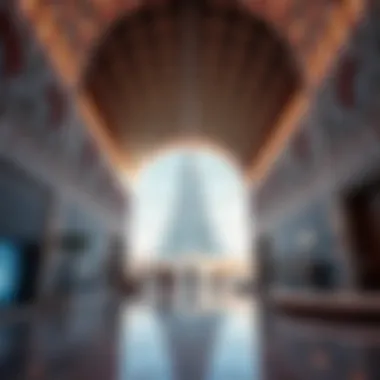
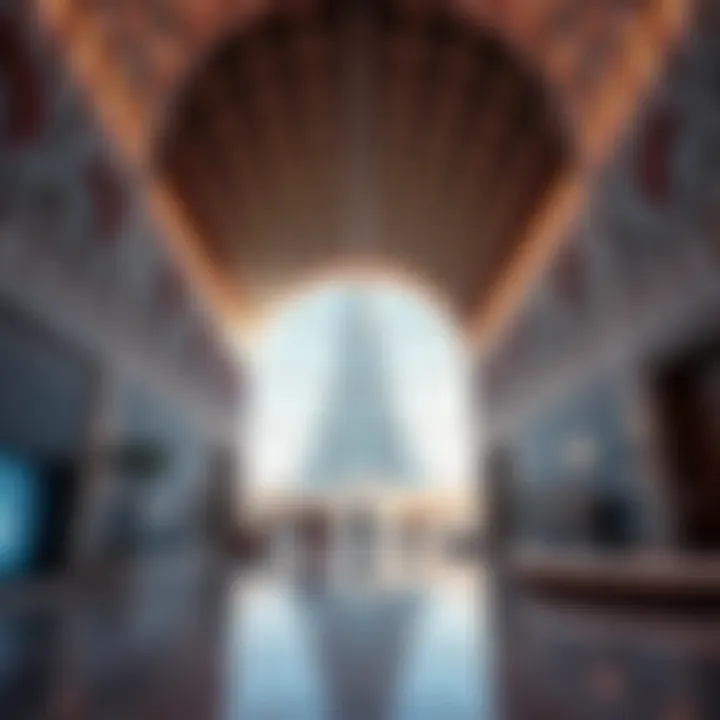
- Workshops aimed at teaching citizens about sustainable living practices.
- Presentations by leading global thinkers on the latest advancements in sustainability.
- Opportunities for local businesses to showcase eco-friendly innovations.
This drive toward sustainability is not merely about dialogue; it encourages action. Visitors leave not only with knowledge but also with a sense of responsibility and the tools to make tangible changes in their own communities.
Fostering Innovation Across Borders
Another critical role that the Museum of the Future plays is in fostering innovation across geographic boundaries. In an era where technology knows no borders, the museum becomes a melting pot for inventive ideas and cross-cultural collaborations. It invites innovators, entrepreneurs, and thinkers from around the globe to share their insights and breakthroughs in technology and design. By providing a platform to discuss and develop these innovations, the museum catalyzes initiatives that could reshape industries and influence lifestyles.
The collaborative environment nurtures a spectrum of ideas, from smart city technologies to advances in artificial intelligence, which can lead to impactful global innovations. Some key aspects include:
- Networking opportunities for entrepreneurs and startups.
- International hackathons that encourage creative problem-solving.
- Showcasing new technologies that address global issues, such as water scarcity or energy efficiency.
By acting as a bridge between cultures and ideas, the Museum of the Future reinforces Dubai's commitment to being a leader in innovation. The museum ultimately catalyzes discussions that might lead to solutions for problems that transcend borders, demonstrating that innovation is best achieved when minds from every corner of the world come together.
Challenges and Criticisms
As with any ambitious endeavor, the Dubai Museum of the Future has not escaped scrutiny and critique. Understanding the challenges and criticisms surrounding this monumental institution is essential for a well-rounded view of its place within the cultural and economic fabric of Dubai. While the museum represents a significant leap forward in architectural design and technological innovation, it also raises pertinent questions about logistics, finances, and cultural representations. \n\nFrom logistical hurdles related to its construction and operation to financial implications that concern various stakeholders, addressing these challenges provides critical insight into how such an ambitious project can succeed while navigating potential pitfalls. Criticism, often reflecting public sentiment or professional assessment, helps in holding institutions accountable. It fosters transparency and encourages continuous improvement—elements that are crucial for the Museum of the Future to achieve its ambitious goals.
Logistical and Financial Hurdles
Logistical challenges pose substantial obstacles for the Dubai Museum of the Future. Crafting such a landmark in a densely populated urban environment requires meticulous planning. The museum’s location, within the bustling heart of Dubai, amplifies the complexity of ensuring smooth operations amidst ongoing city activities. Think about the transportation of materials, or the integration of local infrastructure. These aspects are not just administrative tasks; they embody the heartbeat of a project that aims to be a beacon of future innovation.
Financially, funding a project of this magnitude is no small feat. Balancing construction costs with ongoing operational expenses often leads to a tightrope act for investors and developers. Unexpected costs can arise from various areas, such as labor, materials, and regulatory compliance, potentially leading to budget overruns. For investors, understanding the return on investment and the anticipated visitor numbers is vital. The financial model must provide realistic projections to fortify confidence in the museum’s viability.
Furthermore, local economic conditions and global influences can swing the financial pendulum. When investors weigh their options, having insight into these hurdles shapes their decision-making. If the initial phases of funding create uncertainty, sustaining such an iconic institution could become problematic. \n\n### Cultural Sensitivity in Presentation
Cultural sensitivity is another critical topic when discussing the Museum of the Future. This institution aims to explore themes related to innovation and society, but it must navigate the rich tapestry of local and global cultures delicately. Ensuring that exhibitions and narratives presented are respectful and inclusive is paramount. Presenting technology and futuristic concepts without grounding them in cultural realities can create a disconnect.
Moreover, the potential for cultural misrepresentation exists, particularly when dealing with traditions or customs that may differ vastly from Western perspectives on progress and innovation. This necessitates a collaborative approach when curating exhibitions that engage diverse stories and origins. Consulting cultural experts and engaging local communities in the narrative development process is essential.
When a museum places significant emphasis on bringing forth voices from different cultures, it not only enhances its credibility but also serves as a platform for dialogue and reflection. This approach not only educates visitors but deepens their understanding of the complexities surrounding future technologies amidst varying cultural contexts.
Addressing both the logistical hurdles and cultural sensitivities is not merely a challenge but an opportunity for the Museum of the Future to lead by example, showcasing how institutions can thrive while being responsive to both economic realities and cultural narratives.
Future Prospects
Discussing the future prospects of the Dubai Museum of the Future isn't just about looking at what's ahead. It's about examining the potential ripple effects this remarkable institution could have on a broader scale. As a nexus of innovation and culture, the museum is positioned to be a key player in Dubai's evolution, especially within the technology and real estate sectors. The emphasis on sustainability and cross-disciplinary collaboration makes it an appealing proposition for investors and developers alike.
Potential Expansion Plans
The future holds promising expansion plans for the Museum of the Future. As Dubai increasingly asserts itself on the global stage, the museum's leadership is pondering additional projects that could enhance its offerings. This could include:
- New Exhibitions: Expanding the range of themes covered, such as artificial intelligence, climate change, and virtual reality, would elevate its recognition as a center for future technologies.
- Partnerships with Global Institutions: Collaborating with leading universities and research centers worldwide can bring in fresh insights and innovative exhibits, making it a truly global institution.
- Community Engagement Initiatives: To expand its reach, the museum may roll out programs that directly engage local communities, providing projects that resonate with residents and foster a culture of innovation.
Such developments not only serve to attract more visitors but could also enhance property values in the surrounding areas, making real estate investments increasingly lucrative.
Ongoing Innovations
Staying ahead of the curve means constantly innovating. The Museum of the Future isn't merely a static entity; it's a living, breathing hub of ideas and creativity. Here are some ongoing innovations that will shape its future:
- Interactive Technologies: The incorporation of Augmented Reality (AR) and Virtual Reality (VR) in exhibits allows visitors to delve deeply into the subject matter, making learning an immersive experience.
- Sustainability Initiatives: The museum leads by example, adopting green technologies for its operations. From smart energy solutions to waste management systems, its ongoing commitment to sustainability sets a benchmark for similar institutions.
- Digital Platforms: With a growing digital audience, the museum is likely to enhance its online presence, providing virtual tours and resources that are accessible globally, allowing for a wider reach.
These innovations will not just position the museum as a leading institution in Dubai but as a key contributor to global discourses about the future, ensuring its relevance for years to come.
As the world changes, so does the Museum of the Future, paving the way for groundbreaking ideas and transforming how we perceive tomorrow.
Epilogue
As we reach the end of our journey through the Dubai Museum of the Future, it is evident that this institution transcends mere architectural brilliance and entertainment value. Its significance runs deep, influencing not only the cultural milieu of Dubai but also its economic, educational, and global discourses. Understanding its impact is essential for various stakeholders, including investors, real estate developers, and curious expatriates looking to immerse themselves in the innovative spirit of the emirate.
Final Thoughts on the Museum’s Impact
The museum operates as a lighthouse for contemporary thought and futurism. By examining the museum's commitment to technology and sustainability, we can recognize its role in shaping both local and international narratives on pressing issues. It encourages conversations that resonate far beyond its walls, touching on themes such as climate change, urbanization, and innovation.
- Cultural Relevance: This venue fosters a connection between tradition and future aspirations. It aims not just to exhibit what lies ahead but also to reflect on the legacy that informs our strides towards the future.
- Economic Influence: The museum draws numerous tourists, contributing significantly to Dubai’s economy. This infusion of visitors stimulates surrounding businesses and creates job opportunities, perpetuating a cycle of growth.
- Educational Outreach: Through workshops and collaborations with educational institutions, the museum serves as a platform for knowledge sharing, enhancing the educational landscape in the region.
"The Museum of the Future isn't just about what's next; it's about understanding where we've come from and how to bridge that gap."
For further insights on similar cultural landmarks, check out Britannica or learn more about Dubai’s evolution at Wikipedia.
Engagement with the Museum of the Future is not merely a visit; it’s an invitation to be part of a larger conversation on what it means to live, learn, and innovate in today's world.



